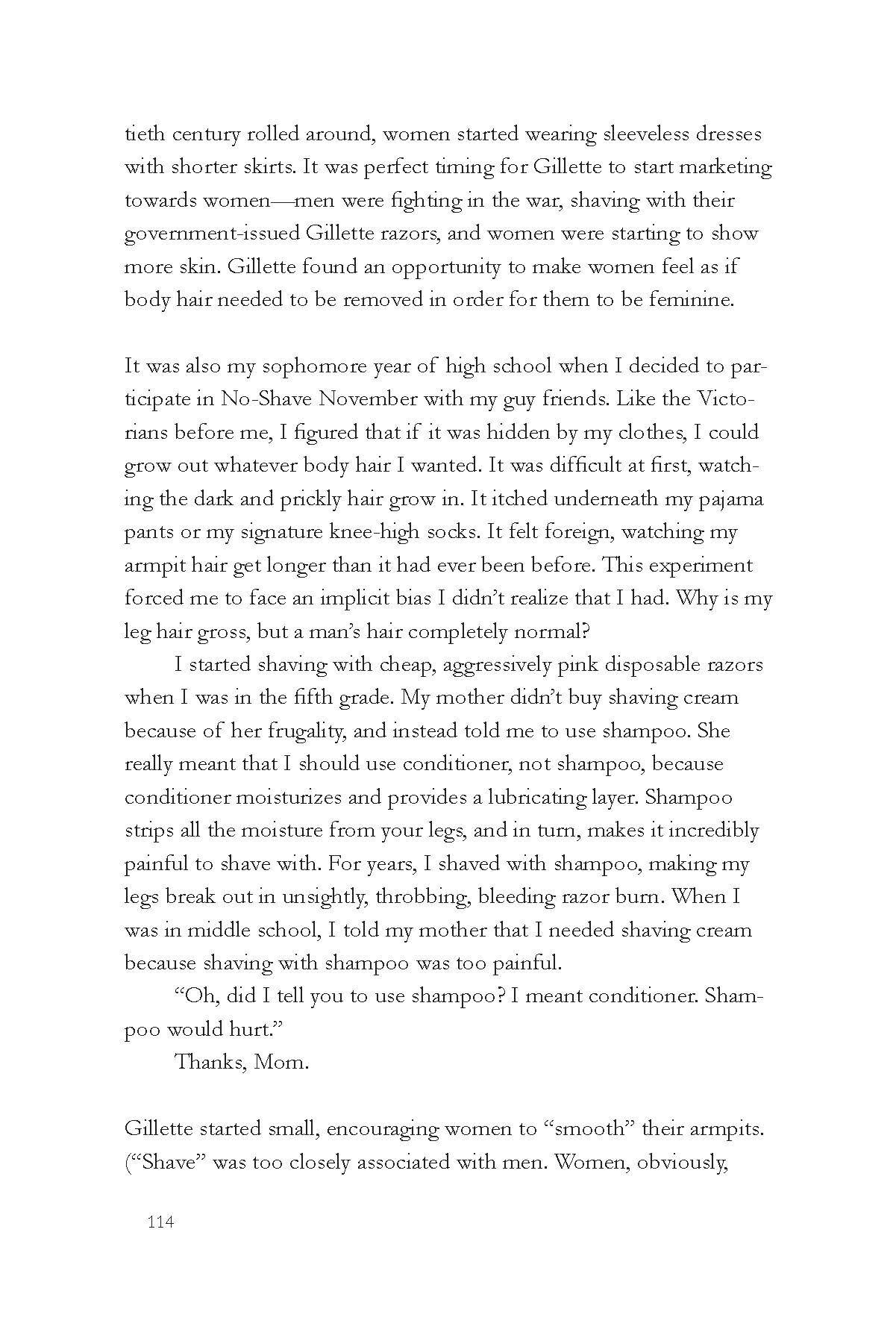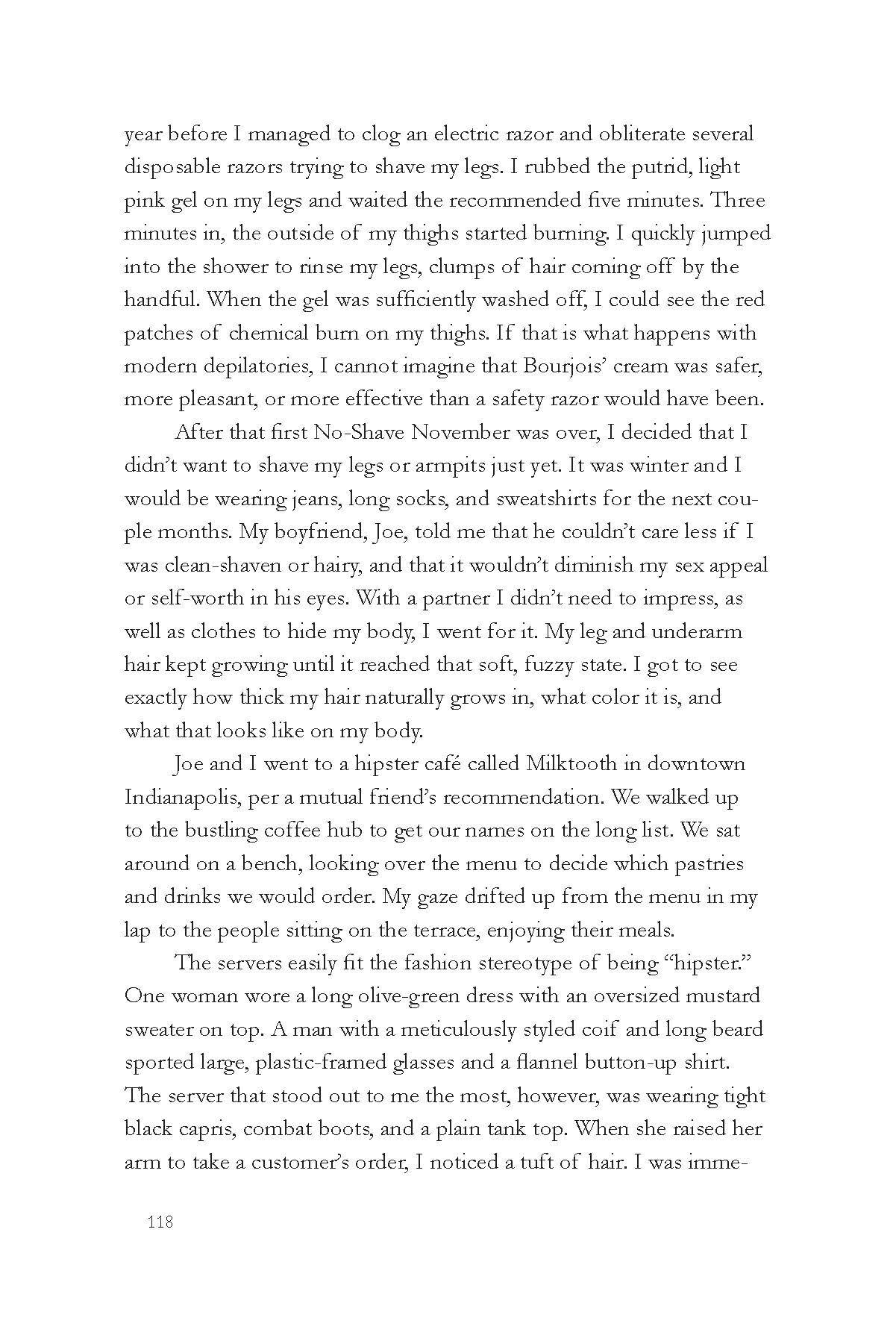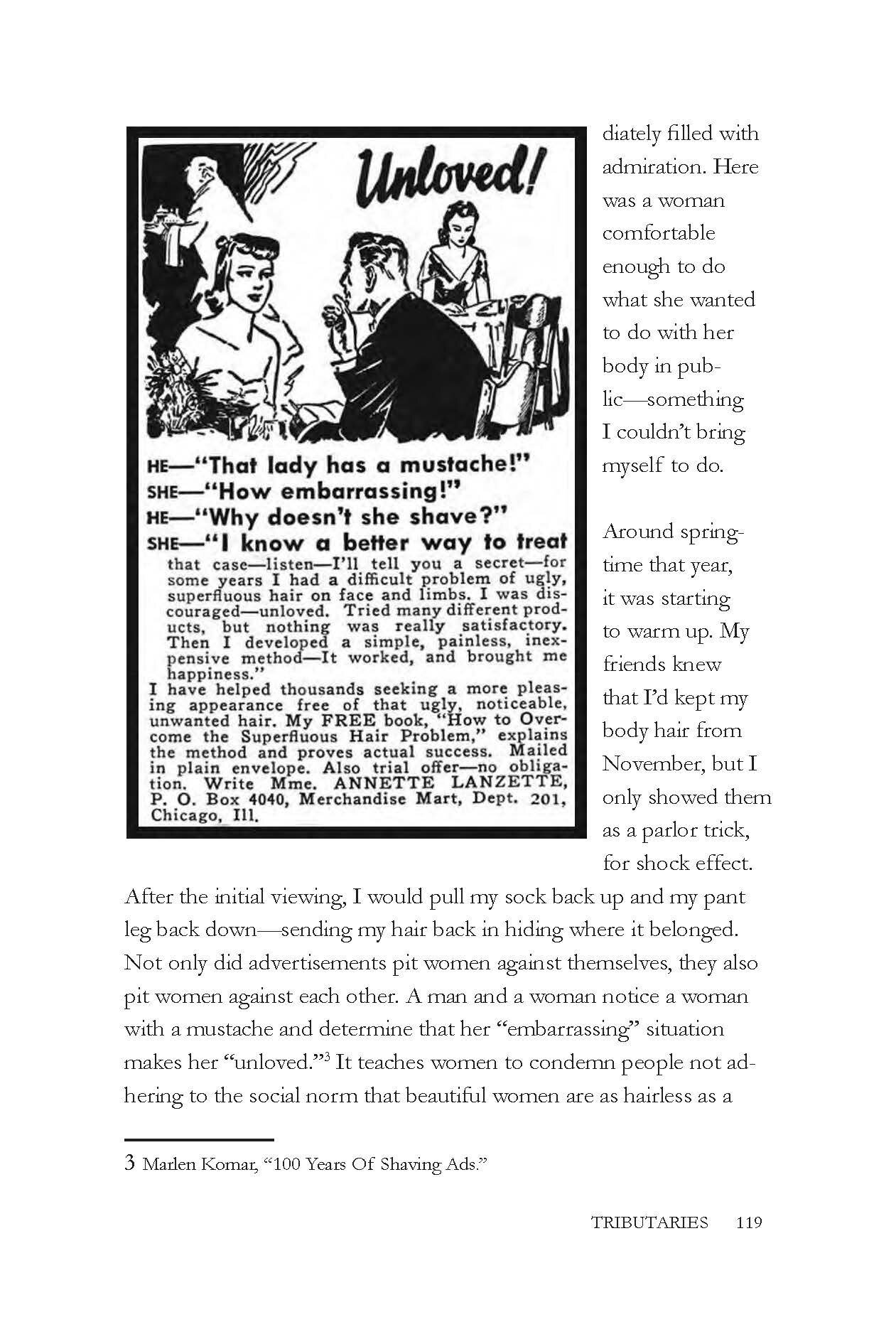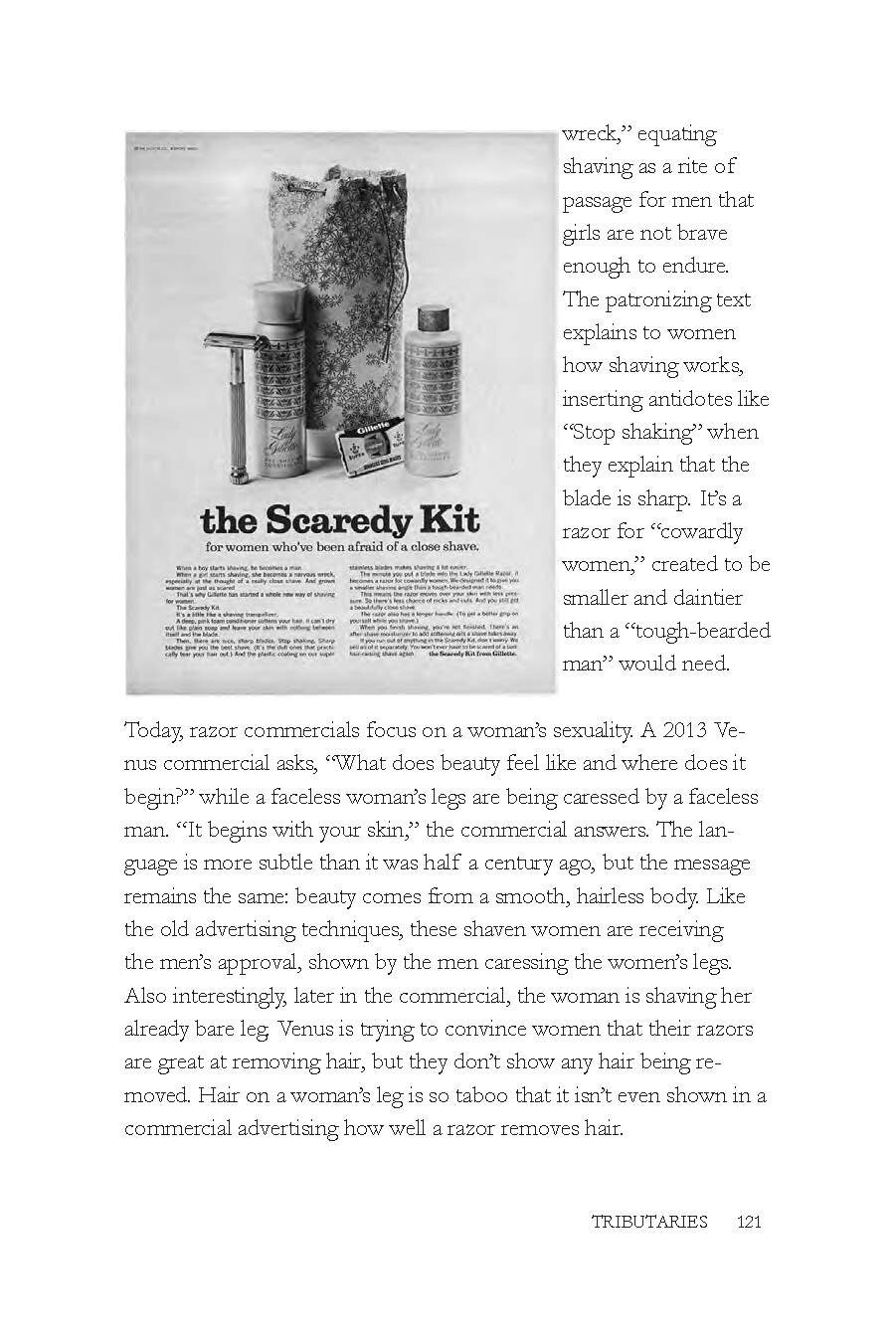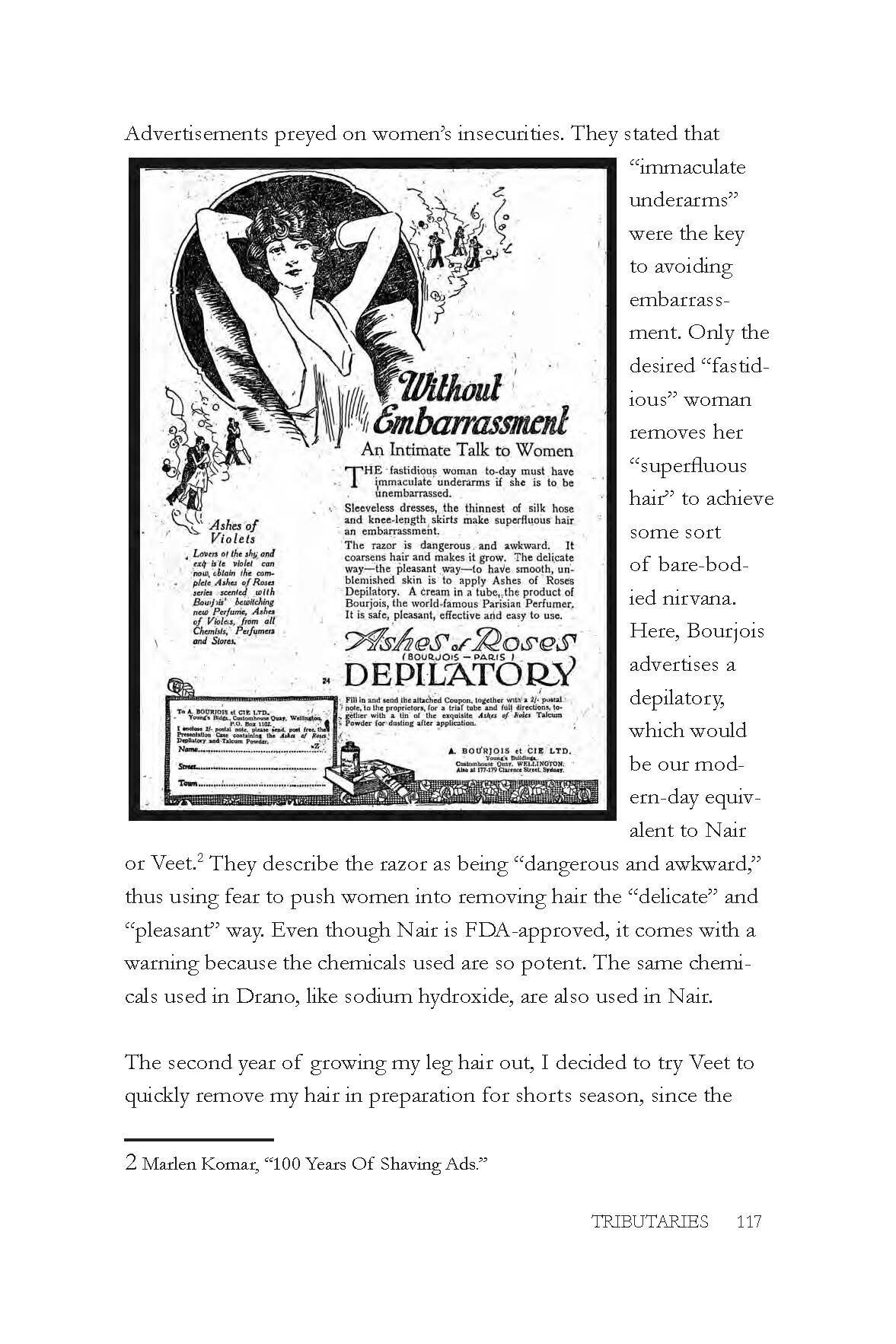Hairy Women
When I was a sophomore in high school, my chemistry teacher, Ms. Felisberto, had unapologetically hairy legs. She was a slender young woman, out of college by only a few years. She was the kind of woman who did good things for the world without making a huge fuss about it. She donated her hair. She gave blood every eight weeks. She had a Gay-Straight Alliance poster above her door, informing students that her room was a safe place. And she had hairy legs.
I was in her first period Chemistry I class, and I remember the first time she wore a dress that revealed her legs. It wasn’t blatantly obvious to me at first—alarms didn’t go off in my head and I wasn’t nauseated to the point of vomiting when she walked in. After maybe ten minutes of class, I noticed that there was a pattern on her pale legs, and upon second glance, the pattern was not from tights, but rather her body hair.
I thought, “Oh, okay.” That was it. The other students in my class, however, were not so forgiving. Far from her classroom, they would call her “disgusting” and “a hairy lesbian.”
The first razor specifically created and marketed towards women was made in 1915 by King Gillette. Up until that point, the safety razor was marketed towards men, trying to convince them to make the switch from straight-edge razors. Gillette pretty much had the market under his control by the 1910s’. His razors were contracted by the War Department to soldiers fighting overseas in WWI.
Previously in the Victorian era, women had no need to shave because they wore long dresses that hid most of their bodies. By the time the twentieth century rolled around, women started wearing sleeveless dresses with shorter skirts. It was perfect timing for Gillette to start marketing towards women—men were fighting in the war, shaving with their government-issued Gillette razors, and women were starting to show more skin. Gillette found an opportunity to make women feel as if their body hair needed to be removed in order for them to be feminine.
It was also my sophomore year of high school when I decided to participate in No-Shave November with my guy friends. Like the Victorians before me, I figured that if it was hidden by my clothes, I could grow out whatever body hair I wanted. It was difficult at first, watching the dark and prickly hair grow in. It itched underneath my pajama pants or my signature knee-high socks. It was foreign watching my armpit hair get longer than it had ever been before. This experiment forced me to face an internalized bias I didn’t realize that I had. Why is my leg hair gross, but a man’s hair completely normal?
I started shaving with cheap, aggressively pink disposable razors when I was in the fifth grade. My mother didn’t buy shaving cream because of her frugality, and instead told me to use shampoo. She really meant that I should use conditioner, not shampoo, because conditioner moisturizes and provides a lubricating layer. Shampoo strips all the moisture from your legs, and in turn, makes it incredibly painful to shave with. For years, I shaved with shampoo, making my legs break out in unsightly, throbbing, bleeding razor burn. When I was in middle school, I told my mother that I needed shaving cream because shaving with shampoo was too painful.
“Oh, did I tell you to use shampoo? I meant conditioner. Shampoo would hurt.”
Thanks, Mom.
Gillette started small, encouraging women to “smooth” their armpits. (“Shave” was too closely assigned to men and the manly act of shaving their faces. Women were, obviously, more delicate, and thus required a more delicate vocabulary.) Sleeveless dresses were being advertised in magazines next to advertisements describing underarm hair as being “an embarrassing personal problem.” Not to mention the subtle racism of calling a “white and smooth” underarm a feature of good dressing and grooming. Bustle magazine explains that advertisers and magazine editors sold their products not by meeting women’s needs, but rather by creating needs women did not previously have. For the last several hundred years, women did not need to shave, but now suddenly, they needed to remove their unsightly underarm hair in order to be presentable.
This didn’t happen to men. Fashion does come and go, but it is hegemonic for men. As a collective whole, they decided when the norm was to be clean-shaven, mustachioed, goateed, or hipster bearded. Women, however, were told by advertisements when it was time to shave their armpits and legs. Before then, women were content with being hairy, not even aware that there was an issue with their body hair. When advertisements deemed leg hair as unsightly, there was some push back from women, but ultimately advertisements won and women shaved their legs. Today, more women are deciding to grow their body hair out, but these women are far and few in between, facing more ridicule than a bearded man would. My boyfriend has long hair that he often has in a bun. He does receive snide comments from the older generation, like by my uncle or grandparents, but these are in good spirits. At no point has his “man bun” ever been deemed as gross. More often than not, people tell my boyfriend that his curly mane is beautiful. I have not been so lucky with my hair.
Sophia and I went to the McDonald’s in Broad Ripple to wait in line for their promotional Szechuan sauce. It was an unusually and uncomfortably hot day for October, but we still wore jeans and long sleeves. I had already decided to stop shaving around mid-September, and I had to suffer through the heat to hide my unsightly leg hair. In line ahead of us stood a woman sporting some high-waisted short shorts and hairy legs. I didn’t even notice her at first, but Sophia motioned for me to look over to her.
“I wish I could pull that off,” Sophia sighed. Her dad is from Turkey, giving her a dark complexion with dark hair. She tells me that she used to have much more body hair before she went on birth control, but her hormones have been regulated by the pill and her hair is not as thick as it was.
“If you didn’t feel pressured to shave, would you?” I asked her.
“Of course not.”
Advertisements preyed on women’s insecurities. They stated that “immaculate underarms” was the key to avoiding embarrassment. Only the desired “fastidious” woman removes her “superfluous hair” to achieve some sort of bare-bodied nirvana. Here, Bourjois advertises a depilatory, which would be our modern-day equivalent to Nair or Veet. They describe the razor as being “dangerous and awkward,” thus using fear to push women into removing hair the “delicate” and “pleasant” way. Even though Nair is FDA-approved, it comes with a warning because the chemicals used are so strong and potent. The same chemicals used in Drano, like sodium hydroxide, are also used in Nair.
The second year of growing my leg hair out, I decided to try Veet to quickly remove my hair in preparation of shorts season, since the year before I managed to clog an electric razor and obliterate several disposable razors trying to shave my legs. I rubbed the putrid, light pink gel on my legs and waited the recommended five minutes. Three minutes in, the outside of my thighs started burning. I quickly jumped into the shower to rinse my legs, clumps of hair coming off by the handful. When the gel was sufficiently washed off, I could see the red patches of chemical burn on my thighs. If that is what happens with modern depilatories, I cannot imagine that Bourjois’ cream was safer, more pleasant, or more effective than a safety razor would have been.
After that first No-Shave November was over, I decided that I didn’t want to shave my legs or armpits just yet. It was winter and I would be wearing jeans, long socks, and sweatshirts for the next couple months. My boyfriend, Joe, told me that he couldn’t care less if I was clean-shaven or hairy, and that wouldn’t diminish my sex appeal or self-worth in his eyes. With a partner I didn’t need to impress, as well as clothes to hide my body, I went for it. My leg and underarm hair kept growing until it reached that soft, fuzzy state. I got to see exactly how thick my hair naturally grows in, what color it is, and what that looks like on my body.
Joe and I went to a hipster café called Milktooth in downtown Indianapolis, per a mutual friend’s recommendation. We walked up to the bustling coffee hub to get our names on the long list. We sat around on a bench, looking over the menu to decide which pastries and drinks we would order. My gaze drifted up from the menu in my lap to the people sitting on the terrace, enjoying their meals.
The servers easily fit the fashion stereotype of being “hipster.” One woman wore a long olive green dress with an oversized mustard sweater on top. A man with a meticulously styled coif and long beard sported large, plastic-framed glasses and a flannel button-up shirt. The server that stood out to me the most, however, was wearing tight black capris, combat boots, and a plain tank top. When she raised her arm to take a customer’s order, I noticed a tuft of hair. I was immediately filled with admiration. Here was a woman comfortable enough to do what she wanted to do with it in public—something I couldn’t bring myself to do.
Around springtime that year, it was starting to warm up. My friends knew that I kept my body hair from November, but I only showed them as a parlor trick, shock effect. After the initial viewing, I would pull my sock back up and my pant leg back down—sending my hair back in hiding where it belonged.
Not only did advertisements pit women against themselves, they also pit women against each other. A man and a woman notice a woman with a mustache and determine that her “embarrassing” situation makes her “unlov[able].” It teaches women to condemn people not adhering to the social norm that beautiful women are as hairless as a child. After several generations, women no longer remember a time when shaving was optional, but they keep the mindset from these old ads that hairy women are “ugly” and “unloved.”
I had a friend named Kameron. He was the kind of guy who would take his opinions to the extreme to get a reaction out of people, even if he didn’t believe in what he was saying. He told us that he would dump his girlfriend if she ever became pregnant with his child He told us that he wished that the old lady he accidentally rear-ended had died in the accident.
Kameron told me one day that women having body hair was disgusting. He said women should shave that all off because nobody wanted to see it. Later that day, I asked my friends Leanna and Brenda what they thought about my body hair, and they started laughing to themselves that Joe must like me because it feels like being with a man. By the end of the day, I felt worthless. I was crying by my locker when Leanna and Brenda walked up and asked me what was wrong. I told them that Kameron had called me disgusting and mannish, and they comforted me, even though they had essentially said the same thing to me. The halls were pretty much cleared out while this was happening. While I was mid-sob, somebody walked out of the bathroom, and we looked up to see Ms. Felisberto. I don’t think she heard what happened, but we made brief eye contact while she walked around the corner to her destination.
When women were told they needed to shave their armpits, the societal shift happened within a few short years. When women were told they needed to shave their legs, it took nearly two decades before the trend was solidified. In the 1960s’, Gillette ran an advertisement promoting the “Scaredy Kit,” trying to shame the last of the hairy women into shaving. It notes that “When a boy starts shaving, he becomes a man. When a girl starts shaving, she becomes a nervous wreck,” equating shaving as a rite of passage for men that girls are not brave enough to endure. The patronizing text explains to women how shaving works, inserting antidotes like “Stop shaking” when they explain that the blade is sharp. It’s a razor for “cowardly women,” created to be smaller and daintier than a “tough-bearded man” would need.
Today, razor commercials focus on a woman’s sexuality. A 2013 Venus commercial asks, “What does beauty feel like and where does it begin?” while a faceless woman’s legs are being caressed by a faceless man. “It begins with your skin,” the commercial answers. The language is more subtle than it was half a century ago, but the message remains the same: beauty comes from a smooth, hairless body. Like the old advertising techniques, these shaven women are receiving the men’s approval, shown by the men caressing the women’s legs. Also interestingly, later in the commercial, the woman is shaving her already bare leg. Venus is trying to convince women that their razors are great at removing hair, but they don’t any hair being removed. Hair on a women’s leg is so taboo that it isn’t even shown in a commercial dedicated to how well a razor removes hair.
I hope I have a daughter someday. By then, I want to be able to proudly have body hair and show her that it’s okay to be who you are in your natural state. I want her to know that she doesn’t owe the world anything, especially things that she does not want to do for herself.
I wish I was brave enough to find myself in Ms. Felisberto’s classroom later, after school or during lunch, to ask her how she confidently displayed her hairy legs. I wish she’d told me about her experiences, how she deals with the negative stigma around her from her students and even strangers. I wish she could have given me advice on how I too could someday find that courage and strength to wear cute dresses with “mannish” legs. Instead, I went home that night and shaved my legs and armpits bare.
Works Cited
“A Quick History Of Women & Shaving.” Women You Should Know, 5 July 2017, womenyoushouldknow.net/pit-stop-a-quick-history-of-women-shaving/.
Komar, Marlen. “100 Years Of Shaving Ads Show How We've Been Tricked Into Going Hairless.” Bustle, Bustle, 26 Jan. 2016, www.bustle.com/articles/137072-100-years-of-shaving-ads-show-how-weve-been-tricked-into-going-hairless-photos.
Komar, Marlen. “The Sneaky, Manipulative History Of Why Women Started Shaving.” Bustle, Bustle, 16 Dec. 2016, www.bustle.com/articles/196747-the-sneaky-manipulative-history-of-why-women-started-shaving.
Lubitz, Rachel. “The Unusual and Deeply Sexist History of Women Removing Their Body Hair.” Mic, Mic Network Inc., 13 Aug. 2016, mic.com/articles/151191/the-unusual-and-deeply-sexist-history-of-women-removing-their-body-hair#.gtVx0LGgY.
Pisarcik, Matthew. “The Marketing Powerhouse that was and still is The Gillette Safety Razor Company.” Razor Archive, www.razorarchive.com/gillette-company--marketing-powerhouse/.

